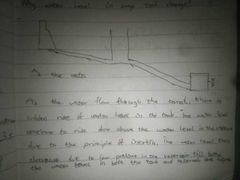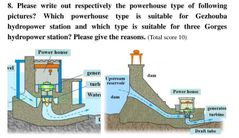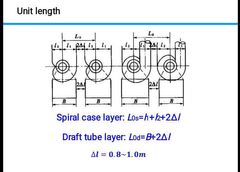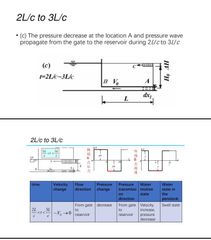![]()
![]()
![]()
Use LEFT and RIGHT arrow keys to navigate between flashcards;
Use UP and DOWN arrow keys to flip the card;
H to show hint;
A reads text to speech;
13 Cards in this Set
- Front
- Back
|
How to classify first-phase water hammer and last-phase water hammer? |
1. The first phase water hammer * The first phase water hammer in a hydropower station with high water head and long pipeline
* In the first phase water, water hammer happens when the amplitude of the water hammer decreases gradually with time
* It happens when when the pto < 1.
* To decrease water hammer at the first phase, close the gate more slowly and then later more quickly.
2. The last phase water hammer * The last phase water hammer occurs in a hydropower station with low water head and short pipeline.
* In the last phase water, water hammer happens when the amplitude of water hammer increase gradually with time until it disappear.
* It happens when pto >1.5
* To decrease water hammer at the first phase, close the gate more quickly and then later more slowly. |
|

Please draw the trend of those two water hammer |

|
|
|
What type of water hammer is more likely to occur in high water head and why? |
* The first phase water hammer occur in high water head
* In the first phase water, water hammer happens when the amplitude of the water hammer decreases gradually with time.
* High water head power station has a long pipeline and the first phase water hammer is likely to occur.
* Since it has long pipeline, it takes a longer time for the amplitude of the water hammer to decrease gradually.
* Draw from the book |
|
|
Why does shortening the length of pressure pipe reduce water hammer value |
1. The shorter the pipe is, the faster the water can flow smoothly.longer pipes easily causes water hammer. When a valve closes quickly, it creates a shockwave effect for the water in the pipe. Its velocity is too rapidly stopped and the water crashes within the pipe system.
2. Long lengths of pressure pipe can result in excessive water velocity, which worsens the effects of water hammer when it is caused by the closing of valve. Therefore, shortening of pressure pipe can reduce the excessive water velocity which can then reduce water hammer.
3. Shortening the pipe can cause rapid pressure change which can help reduce water hammer.
4. If the pressure pipe is short, the pressure wave passes through the pipe more quickly and this can decrease the amplitude of the water hammer more quickly
5. Short pressure pipes can prevent cavitation which cause water hammer |
|
|
What should be considered when designing a simple surge chamber? |
A surge tank is a standpipe or storage reservoir at the downstream end of a closed aqueduct, feeder, dam, barrage pipe to absorb sudden rise of pressure, as well as to quickly provide extra water during a brief drop in pressure. Determining conditions in designing surge tank * Surge tank are installed either at the lower end of a pressure diversion conduit to link the diversion conduit to penstock . * Surge tank can also be installed at the lower end of long penstocks leading from a dam to an isolated power house. * Surge tank may also be provided at the upper end of a long tailrace diversion system. * The surge tank should be of sufficient height to prevent overflow for all conditions of operation. The height of a surge tank is governed by the highest possible water level that can be anticipated during its operation* The surge tank must have sufficient cross sectional area to ensure stability. Determining procedures and parameters * Fill the penstock with water. * Open the gate. * The velocity of water in the penstock increases to Vmax. *Whether or not conduit requires a surge tank depends on its Tw. 'Tw' is the time taken for Vmax to last. 'Tw'=(£𝑙𝑖𝑣𝑖)/𝑔𝐻𝑝> [𝑇w]=3~6s * If Tw>6s, we need to construct surge tank. As s |
|
|
Why water level in surge tank changes? |

|
|
|
a. How to classify surface powerhouse station type? b. Location relationship respectively between dam and powerhouse for different surface powerhouse station type |
a.a. Powerhouse In river channel( Like Gezhouba dam) - Low water head - Large flux
b. Powerhouse At dam toe(三峡大坝) - High water head - Large flux
c. Powerhouse On river bank - High water head - Little flux
d. Powerhouse In dam - High water head - Short penstock
2. Location relationship * Powerhouse In river channel( Like Gezhouba dam) - Located at flat areas - Located at where there is little water storage
* Powerhouse At dam toe(三峡大坝) - Located in a valley or mountain area where there's high flux.
* Powerhouse On river bank - Located on river bank with little flux |
|

|
a. Powerhouse in river channel ii. Powerhouse at dam toeb. Gezhouba- Powerhouse in river channel * Low water head * Located in flat areas powerhouse section and spillway section are located in the wide river to hold off water * To keep out the water, the upstream side walls are thick. ii. 三峡大坝- Powerhouse at dam toe * High water head * Has reservoir to collect and store water. * Mostly found at valley or mountain area |
|
|
Factors considered in determining the location of powerhouse |
*Geological constraints - To ensure stability of powerhouse, the Powerhouse must be founded on rock.
* Topography constraints - The land form can have influence on the location of the powerhouse. For example, steep slope land or banks can bring about stability problems and also difficulties in excavation.
* Length of conduit The distance between the dam and the powerhouse station should of short distance to prevent excess energy loss during the water flow.
* Climatic constraints We have to take into consideration the climate at the location site of powerhouse. This help to ensure effective thermal and temperature control. This also help us to know the dam type and material to use for construction
* Heights of tailwater Due the occurance of flood, we need to consider the height of the tailwater to help determining the level or platform for the powerhouse.
* Dam type For selection of the location, we need to consider the dam type whether underground powerhouse or surface powerhouse. For underground, we need to take into consideration the availability of mountain or pit area and also the location for each caverns(switchyard cavern, etc.) |
|
|
How to determine the length of powerhouse |

a.Total Length =Number of unit × Unit length + assembly length + add length b. Unit length Determined by the layout of the turbine, draft tube, generator layer.- Spiral case layer: L0s=l1+l2+2∆l- Draft tube layer: L0d=B+2∆l∆l=0.8~1.0m - Generator layer: L0g=φ3+δ3+b b=(1.5~2m) Draw to define Lo= max(Los, Lod, Log) c. Add length Outside wall, expansion joint in the terminal unit. Crane in the side unitValve condition |
|

|
* The water in the swell state* Pressure decrease* The velocity of the water increases from -Vo to 0. * The transmission of the water hammer pressure is from gate to reservoir * The time period for this process is 2L/c <t<3L/c |
|
|
Harm of water hammer to powerhouse |
•Fracture of pipeline - When the pipe is strong enough or does not have high thickness, water hammer pressure can cause fracture to the pipe.•Internal pressure instability Due to the increase and decrease of pressure in the pipe system, there is no stability of internal pressure in the reservoir and the conduit as well.•Cause the pipe to collapse and implode The expansion and contraction of the pipe during the process of water hammer cause the pipe to collapse.•Influence generating efficiency |
|
|
What will happen to wster hammer if cross-sectional area of conduit is increased? |
* If cross-sectional area of conduit is increased, the water hammer pressure is reduced. * When the cross-sectional area of the conduit is increased, the velocity of the water is decrease. This help reduces the effect of the water hammer pressure. * The closure time Ts, of the gate is increased since the velocity of the water flow is decreased when the cross-sectional area of the conduit is increased. |

